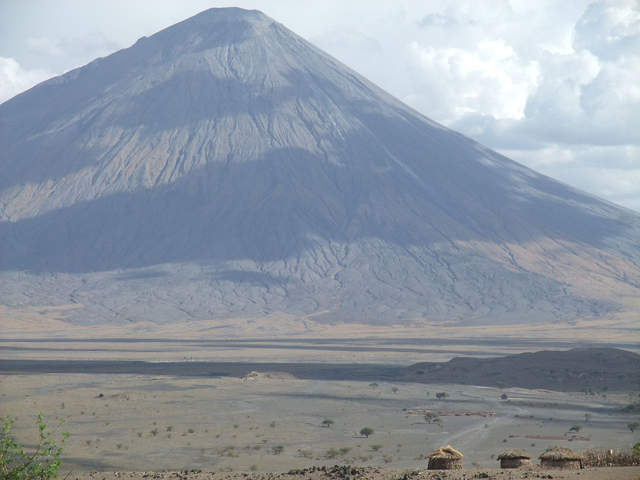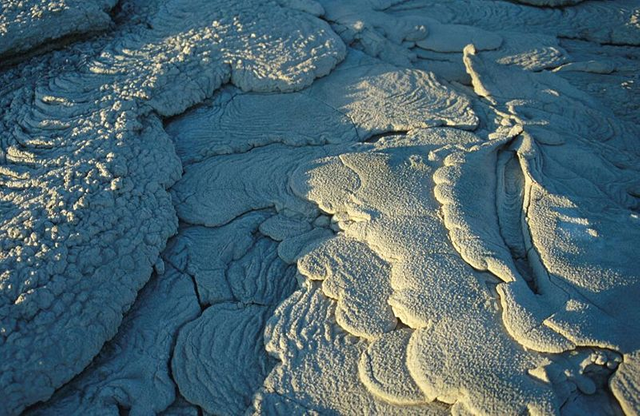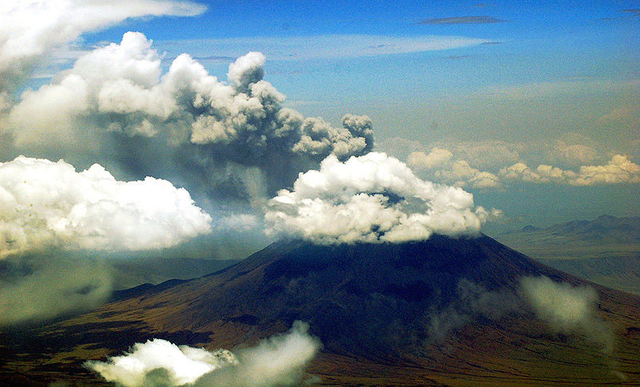The Mountain of God: Ol Doinyo Lengai
Ol Doinyo Lengai, located in Tanzania, is the only known actively erupting carbonatite volcano on the planet (specifically, natrocarbonatites), and is one of the most unique volcanic landscapes on the planet. Carbonatite lavas are unique- they're volcanic rocks with high levels of carbon that occur only in tectonic rifting zones. Ol Doinyo Lengai's magma also contains high levels of sodium, meaning that the magma is water soluble. It also looks nothing like you'd expect magma to look like, as you can see in the video posted below. The magma has been known to freeze in midair, and shatter upon hitting the ground. Short lived, ethereal magma sculptures hanging off rocks also show up frequently.

Ol Doinyo Lengai. [Image source]
Despite being a volcano with extremely low viscosity lava (the lowest of any volcano on the planet, in fact), it does not take on the shield volcano shape one would expect- instead it more closely resembles a stratocone with an unusual flat top. The unusual shape is likely the product of at least a couple of processes. First off, and likely most importantly: even though the lava does have extremely low viscosity, its low temperatures mean that it solidifies rapidly, which means it only travels distances comparable to more viscous lavas. Secondly, the rapid erosion rate of natrocarbonatite lava deposits would also help it maintain its shape. This can be seen in the countless erosion channels visible on its slopes.
The flat top is covered in hornitos, lava lakes, lava flows, and craters. It never stays the same for long. It rapidly changes its shape from year to year- if one were to create a time lapse video of it compared to any other active volcanic terrane filmed at the same speed, it would shift, grow and change at an astonishingly swifter rate.
Old Doinyo Lengai translates to “Mountain of God” in Maasai. The carbonatite ash and erosive products scattered over the nearby grasslands have resulted in an immensely fertile local region, which is an important part of wildebeest migrations, as well as excellent pastureland for the Maasai. There are a few older extinct carbonatite volcanoes near Ol Doinyo Lengai, most notably Mount Homa, in western Kenya.

Solidified lava on Ol Doinyo Lengai. [Image source]
Ol Doinyo Lengai erupts quite regularly, with a relatively major eruption as recently as 2007-2008. Others occurred in 1966, 1940, 1926, and 1917. Frequent volcanic activity in between the major eruptions has been recorded as far back as 1883.
Carbonatites frequently contain high quantities of niobium and other economically important elements, including uranium, copper, fluorine, and more. Carbonatite deposits in Brazil are mined for niobium, which is used in steel production, cell phones, and a wide range of other uses. The deposits in Brazil, like most other, seem to be related to rifting, (Holz, 2013), and contribute to Brazil's status as the chief global exporter of niobium. Natrocarbonatite and carbonatite magma also tends to make soils incredibly fertile, though this only really comes into application near Ol Doinyo Lengai.

The 2008 eruption of Ol Doinyo Lengai. [Image source]
Carbonatite deposits have actually been predicted on Mars- there do appear to be carbonates on Mars, and carbonatite deposition seems a more likely cause for many of them than the normal carbonate deposition process, which occurs underwater. The lower water levels on Mars would reduce the speed at which carbonatites would weather and erode.
Bibliography:
Mourão, C., Moreira, M., Mata, J., Raquin, A., and Madeira, J., 2011, Primary and secondary processes constraining the noble gas isotopic signatures of carbonatite and silicate rocks from Brava Island: evidence for a lower mantle origin of the Cape Verde plume: Contributions to Mineralogy and Petrology Contrib Mineral Petrol, p. 995–1009.
Bourne Jr., J., 2001, Ol Doinyo Lengai: National Geographic,
Storey, B.C., 1997, An active mantle mechanism for Gondwana breakup: Journal of African Earth Sciences, v. 100.
Gomes, C., Ruperti, E., and Morbidelli, L., 2003 Carbonatite complexes from Brazil: A review: Journal of South American Earth Sciences, p. 51–63.
Holz, M., Troccoli, E., and Vieira, M. Sequence Stratigraphy of Continental Rift Basins I: A Conceptual Discussion of Discrepant Models: Strati 2013, p. 9–13.
https://en.wikipedia.org/wiki/Carbonatite
'Unusual Lava' http://www.geology.sdsu.edu/how_volcanoes_work/Unusual%20lava.html
Savel’Eva, V.B., Bazarova, E.P., and Danilov, B.S., 2014, New finds of carbonatite-like rocks in the western Baikal region: Doklady Earth Sciences Dokl. Earth Sc., p. 1483–1487.
Smithsonian Institution Global Volcanism Program http://volcano.si.edu/volcano.cfm?vn=222120
Marinangeli, L., and Liberi, F., 2013, The presence of carbonates on Mars: origin, terrestrial analogues and analytical tecniques ambiguity: Geophysical Research Abstracts,
https://en.wikipedia.org/wiki/Ol_Doinyo_Lengai
This post started as a school paper and was reprinted in part in an earlier post of mine here on steemit- this is a more complete version.
This is a test comment, notify @kryzsec on discord if there are any errors please.
Being A SteemStem Member
Had to come back to this one, after your last post.
Still surreal to see the white crystallized lava flows. This place is definitely a bucket list place.
It's on my list too!
Great article, as always. I just have one question:
To my eyes, the lava in the video looks like it has a high viscosity as opposed to low viscosity. If you didn't make a mistake in writing, I don't understand the sentence correctly.
Viscosity is the measure of how 'thick' a liquid is and how well it flows- water and the magma in the video have low viscosities, peanut butter has high viscosity.
Ah yes, okay, I guess I got it wrong. I was thinking it was the other way around. Thanks for clarifying.
Your Post Has Been Featured on @Resteemable!
Feature any Steemit post using resteemit.com!
How It Works:
1. Take Any Steemit URL
2. Erase
https://3. Type
reGet Featured Instantly � Featured Posts are voted every 2.4hrs
Join the Curation Team Here | Vote Resteemable for Witness
You received a 80.0% upvote since you are a member of geopolis.
To read more about us and what we do, click here.
https://steemit.com/geopolis/@geopolis/geopolis-the-community-for-global-sciences-update-3
If you do not want us to upvote and comment on your posts concerning earth and earth sciences, please reply stop to this comment and we will no longer bother you with our love ❤️